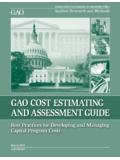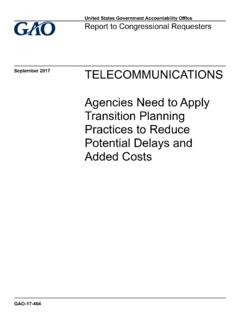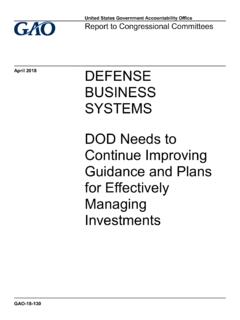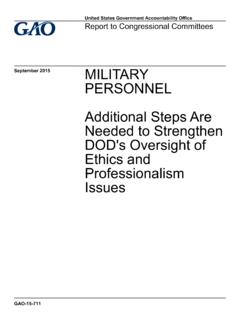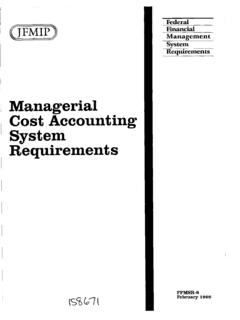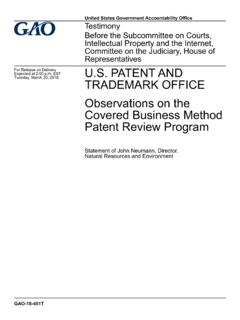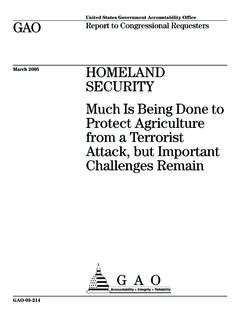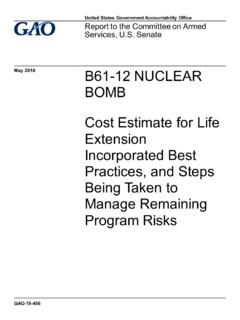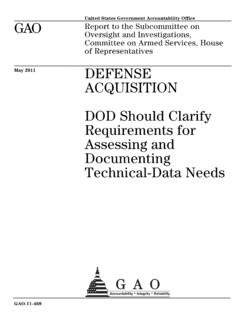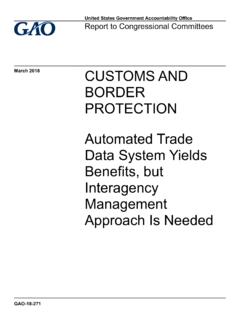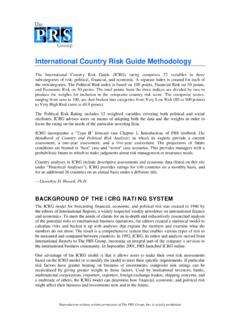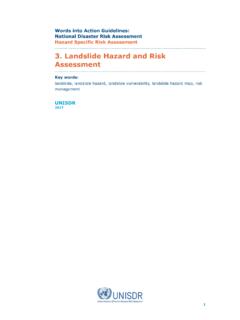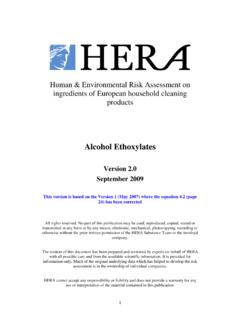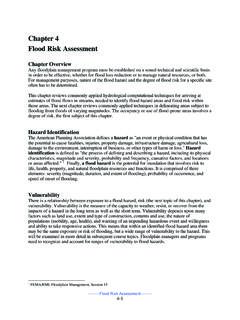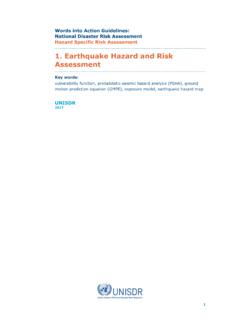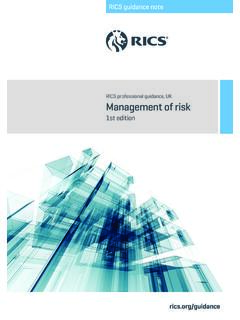Transcription of Schedule Assessment Guide - Government Accountability …
1 December 2015 GAO-16-89 GBest Practices for Project SchedulesScheduleAssessment GuideGAO-16-89 GiPrefacePREFACEThe Government Accountability Office is responsible for, among other things, assisting the Congress in its oversight of the federal Government , including agencies stewardship of public funds. To use public funds effectively, the Government must employ effective management practices and processes, including the measurement of Government program these objectives, in March 2009, we published the GAO Cost Estimating and Assessment Guide as a consistent methodology based on best practices that can be used across the federal Government to develop, manage, and evaluate capital program cost estimates.
2 The methodology outlined in the Cost Estimating and Assessment Guide is a compilation of best practices that federal cost estimating organizations and industry use to develop and maintain reliable cost estimates throughout the life of an acquisition Schedule Guide is a companion to the Cost Guide . A cost estimate cannot be considered credible if it does not account for the cost effects of Schedule slippage. An effective methodology for developing, managing, and evaluating capital program cost es-timates includes the concept of scheduling the necessary work to a timeline, as discussed in the Cost Guide . Typically, Schedule variances are followed by cost variances and man-agement tends to respond to Schedule delays by adding more resources or authorizing overtime.
3 Therefore, a reliable Schedule can contribute to an understanding of the cost impact if the program does not finish on time. Further, a Schedule risk analysis allows for program management to account for the cost effects of Schedule slippage when de-veloping the life-cycle cost estimate. Thus, a well-planned Schedule is a fundamental management tool that can help govern-ment programs use public funds effectively by specifying when work will be performed in the future and measuring program performance against an approved plan. Moreover, as a model of time, an integrated and reliable Schedule can show when major events are expected as well as the completion dates for all activities leading up to them, which can help determine if the program s parameters are realistic and achievable.
4 Additionally, a well-formulated Schedule can facilitate an analysis of how change affects the program. Accordingly, a Schedule can serve as a warning that a program may need an overtarget budget or GAO Schedule Assessment Guide develops the scheduling concepts introduced in the Cost Estimating and Assessment Guide and presents them as ten best practices associated with developing and maintaining a reliable, high-quality Schedule . The GAO Schedule Assessment Guide also presents guiding principles for auditors to evaluate certain aspects of Government intend to update the Schedule Assessment Guide to keep it current. Comments and suggestions from experienced users, as well as recommendations from experts in the scheduling, cost estimating, and program acquisition disciplines, are always welcome.
5 If you have any questions concerning this Guide , you may contact me at (202) 512-6412 or Contact points for our Office of Congressional Relations and Office of Public Affairs may be found on the last page of this Guide . Major contributors to this project are listed in appendix X. Timothy M. Persons, Director, Center for Science, Technology, and Engineering Applied Research and MethodsGAO-16-89 GiiiContentsCONTENTSP reface ..iAcronyms and Abbreviations ..xiIntroduction ..1 Concepts ..3 Ten Best Practices ..3 The Integrated Master Schedule ..5 The Critical Path Method ..6 Planning, Scheduling, and the Scheduler ..7A Process for Creating and Maintaining Reliable Schedules.
6 8 Best Practice 1: Capturing All Activities ..11 Capturing All Effort ..11 Constructing an IMS ..15 The IMS as a Consolidation Tool ..18 Work Breakdown Structure ..20 Activity Names ..22 Activity Codes ..24 Best Practices Checklist: Capturing All Activities ..25 Best Practice 2: Sequencing All Activities ..27 Predecessor and Successor Logic ..28 Early and Late Dates ..30 Incomplete and Dangling Logic ..31 Summary Logic ..34 Date Constraints ..36 Using Date Constraints ..38 Lags and Leads ..41 GAO-16-89 GivContentsUsing Lags ..42 Using Leads ..44 Path Practices Checklist: Sequencing All Activities ..46 Best Practice 3: Assigning Resources to All Activities.
7 49 Resources, Effort, and Duration ..49 Rolling Wave Planning ..51 Loading Activities with Resources ..52 Resource Leveling ..57 Best Practices Checklist: Assigning Resources to All Activities ..61 Best Practice 4: Establishing the Duration of All Activities ..63 Estimating Durations ..65 Calendars ..66 Best Practices Checklist: Establishing the Duration of All Activities ..68 Best Practice 5: Verifying That the Schedule Can Be Traced Horizontally and Vertically ..71 Vertical Traceability ..72 Best Practices Checklist: Verifying That the Schedule Can Be Traced Horizontally and Vertically ..73 Best Practice 6: Confirming That the Critical Path Is Valid.
8 75 The Critical Path and the Longest Path ..77 Common Barriers to a Valid Critical Path ..79 Resource Leveling and Critical Resources ..86 Critical Path Management ..87 Program and Project Critical Paths ..88 Best Practices Checklist: Confirming That the Critical Path Is Valid ..89 Best Practice 7: Ensuring Reasonable Total Float ..91 Definitions of Total Float and Free Float ..92 Calculating Float ..93 GAO-16-89 GvContentsCommon Barriers to Valid Float ..93 Reasonableness of Float ..94 Float Management ..95 Best Practices Checklist: Ensuring Reasonable Total Float ..96 Best Practice 8: Conducting a Schedule Risk Analysis ..99 Definition of Schedule Risk Analysis.
9 99 Schedule Uncertainty and Risk ..100 Merge Bias and Schedule Underestimation ..100 Conducting a Schedule Risk Analysis ..102 Collecting Anonymous and Unbiased Risk Data ..105 Schedule Risk Analysis with Three-Point Duration Estimates ..106 Schedule Risk Analysis with Risk Drivers ..108 Prioritizing risks ..110 probabilistic Branching ..113 Correlation ..115 Schedule Contingency ..117 Updating and Documenting a Schedule Risk Analysis ..118 Best Practices Checklist: Conducting a Schedule Risk Analysis ..119 Best Practice 9: Updating the Schedule Using Actual Progress and Logic ..121 Statusing Progress ..122 Progress Records ..125 Adding and Deleting Activities.
10 126 Out-of-Sequence Logic ..126 Verifying Status Updates and Schedule Integrity ..129 Schedule Narrative ..130 Reporting and Communication ..132 Best Practices Checklist: Updating the Schedule Using Actual Progress and Logic ..132 Best Practice 10: Maintaining a Baseline Schedule ..135 Baseline and Current Schedules ..135 Basis Document ..137 GAO-16-89 GviContentsThe Change Process ..138 Baseline Analysis ..140 Trend Analysis ..143 Strategies for Recovery and Acceleration ..145 Best Practices Checklist: Maintaining a Baseline Schedule ..146 Four Characteristics of a Reliable Schedule ..148 Appendix I: Objectives, Scope, and Methodology.
